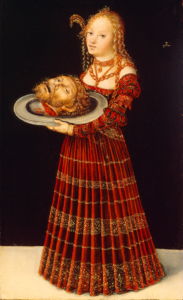Object of the Month: October 2016
Salome with the Head of St. John the Baptist
Oil on panel, Signed: winged dragon symbol (upper right)
Lucas Cranach, the Elder
German, 1472–1553
Click on the links throughout the article to view additional artists’ works and reference material.
A young girl in a lavish red dress with gold trimming stands against a stark black background. Ornate gold necklaces hang from her neck, and on her left index finger, a ring peeks through intricate slashed gloves. Her face has a smug expression as she holds a platter on which rests a man’s severed head.
This painting, by Lucas Cranach the Elder is a sixteenth-century portrayal of Salome with the Head of St. John the Baptist and is based on the Biblical story recorded in Mark 6:14-29. While the image appears morbid to many, one author has pointed out that beheadings like this are frequently seen in Cranach’s oeuvre.
As is often the case with the Old Masters, Cranach did not paint Salome in traditional Middle Eastern clothing, with which he would have been unfamiliar. Instead, he painted her as a contemporary German noblewoman, giving us a glimpse of the beautiful clothing of the time period. It is interesting to note that Cranach’s paintings have proven invaluable to fashion historians and costumers studying and recreating Renaissance dress. One New York designer even created a special exhibition focusing on the slashed gloves that Cranach’s models are often shown wearing!
Perhaps the painting’s most fascinating detail, however, is distinct from the subject matter. In the upper right hand corner is the kleinod, which served as his signature stamp. This symbol of a winged serpent biting down on a ruby was given to Cranach by Frederick the Wise of Saxony. Since Cranach painted at a time when many artists were not even signing their works, this unique signature is particularly striking.
Cranach’s kleinod does at times pose a conundrum for art connoisseurs. Like many well-known and established artists of that time period, Cranach had a large workshop with many craftsmen working with him. Oftentimes these craftsmen worked on details and even produced entire pieces so similar to those of the master that scholars are sometimes left to wonder whether a painting with the kleinod symbol was actually produced by him or simply received his stamp of approval.
In addition to his many Biblical scenes, Cranach was a renowned portraitist. In fact, we owe him a debt of gratitude for providing us with more than one picture of Martin Luther, a personal friend of his. Cranach’s workshop was located in Wittenberg, Germany, the birthplace of the Protestant Reformation. It was here on October 31, 1517 that Martin Luther nailed his ninety-five theses to the church door. Eyre Crowe, an artist for London’s Royal Academy, captured the event over three hundred years later with drama and historical accuracy. Cranach is the bearded man seen looking out at the viewer.
Cranach, who adopted Protestant theology, went on to become the key Reformation artist. As 2017 will mark the 500th anniversary of Luther’s world-changing actions, many museums, including M&G, are paying tribute to his artistic friend, Lucas Cranach the Elder.
Katie Neal, Docent and Customer Service Assistant
Published in 2016
